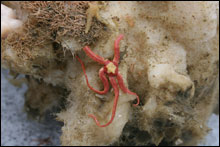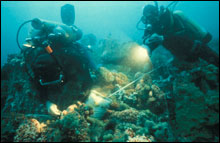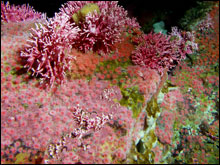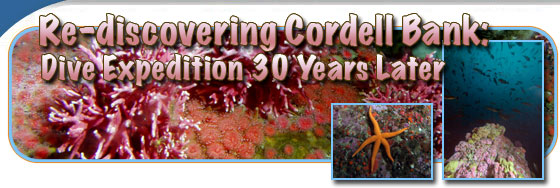Error processing SSI file
|
Collecting Specimens
 |
| Brittle star on sponge sample collected during marine debris removal expedition. (CBNMS/Jennifer Renzullo) |
One of the challenges of studying organisms that live in the deeper parts of the ocean is that we have very limited time and opportunities to make observations of the animals in their natural surroundings and learn how they live and interact with their environment. One way that we can learn about these marine animals is to collect photos and video imagery. However, often it is difficult to identify organisms with photos alone, so having animals in the lab provides us with an opportunity to give these animals their proper scientific names, rather than vaguely describing them based on their general characteristics (for example, 'vase sponge').
One of the objectives of this research cruise is to collect specimens for study in the laboratory. Relatively few specimens have been collected from the Bank, with most of these being collected by the early SCUBA diver explorers from 'Cordell Expeditions' who visited the reef top of Cordell Bank in the 1970's and 80s.
 |
| Cordell Expeditions divers removing samples during earlier dive expeditions. (Cordell Expeditions) |
It takes great dexterity to remove and collect specimens from the Bank. Specialized collection equipment on remotely operated vehicles can be used for collecting organisms from the seafloor, but this task is often slow and laborious. We have chosen to use SCUBA divers for specimen collection during this research trip, since divers are well-suited to the task of maneuvering about the complex Bank environment and collecting and storing fragile organisms.
Identifying the species we collect will help us to understand how the Cordell Bank ecosystem is similar to as well as different from other rocky habitats within the California Current region. Analyzing specimens that are collected from this research trip will also provide an assessment of the health of the Bank and changes that have occurred in the upper Bank community since the collections that were made by Cordell Expeditions several decades ago. For example, the specimens will allow us to screen for the possibility of any non-native invasive species that have found their way to Cordell Bank and could cause harm to the ecosystem of the Bank.
 |
| California hydrocoral surrounded by other invertebrates on Cordell Bank. (CBNMS/Noelani Puniwai) |
In addition to collecting organisms for identification, bringing specimens back to the laboratory also provides us with the opportunity to understand aspects of how these animals live. For example very little is known about the basic biology of deep sea corals that reside on Cordell Bank, such as details about how they reproduce. Small pieces of corals can help us understand when during the year these animals spawn, how many larvae they produce, and likely patterns of larval dispersal, information that will aid in assessing the potential for re-colonization if corals become damaged. One coral of interest on Cordell Bank is the hydrocoral Stylaster californicus.
Cordell Bank is the documented northern extent for this deep coral species, which raises the question - is there a biogeographic break in coral communities in the vicinity of Cordell Bank or does the known range reflect our lack of knowledge of the deep sea ecosystems of northern California?
We are working with partners at California Academy of Sciences to preserve and identify animals collected during this research mission. Organisms collected during this trip will be catalogued and stored in the permanent collection of invertebrates at California Academy of Sciences and will be accessible for further scientific study by a variety of researchers.
|



